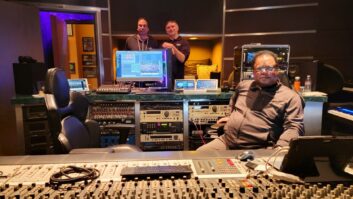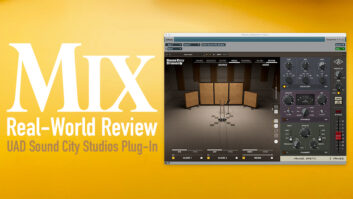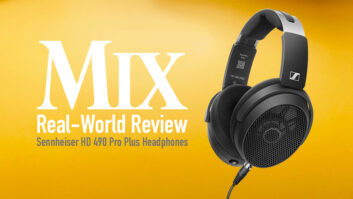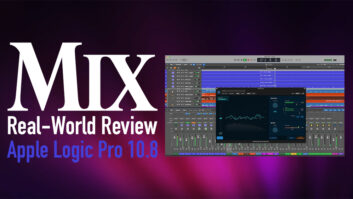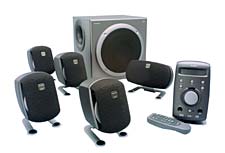
At Winter NAMM this year, after giving Alesis’ ProActive 5.1 systema quick listen on the noisy show floor, I thought this 450-watt,THX-certified surround system was “nice,” with its fivemini satellites, powered subwoofer and remotes (wired and IR) forsystem and I/O control. The $499 list seemed reasonable. Alesis sawthese as a home/PC studio product, but I thought they made more senseas the Auratones for the 5.1 era, offering a realistic representationof what most consumers listen to at home.
When I finally got a system to check out, I was impressed by bothits versatility and sound. The Sound Control Module central controlleris a paperback-size, upright unit with LCD status screen,Input/Mute/Level/Mode buttons, gain control, ⅛-inch headphonejack and ⅛-inch TRS stereo input to connect an MP3 player, CDWalkman, iPOD, etc. The unit connects to the sub via a 5-foot,multipair umbilical with a 15-pin termination that carries all of theanalog signals to the amps.
The rear panel has three ⅛-inch stereo jacks with provided¼-inch/RCA breakout cables to connect to a 5.1 (LCRSS+sub) analogsource — such as a console or playback deck — as well asRCA coaxial and optical jacks to connect to PCM digital stereo orDTS/Dolby Digital/MP3/Dolby Pro Logic feeds from a DVD player,encoder/decoder or workstation.
Setup is (mostly) straightforward. The system includes all necessaryspeaker wire (not the best, but it’s free) to connect the satellites tothe amps built into the sub and small speaker stands that can beinverted for use as wall mounts. One installation mystery: The manualdoesn’t explain the color coding on the RCA breakout cables, so you’reon your own when figuring out which of the front or rear cables is leftor right, or center/sub. However, an onboard tone oscillator can panthrough the system, ID’ing all of the speakers. As the systemautomatically creates a subwoofer feed internally derived from thestereo or 5-channel inputs, there’s no need to connect to the subwooferat all when mixing (uncoded) surround material in the studio, unlessyou need to have a separate LFE feed.
The controller also includes an Effects mode, which allows theselection of input processing for Dolby Digital, DTS, 5.1 analog,stereo-only or “stereo x2.” The latter routes the frontstereo feed to the stereo surrounds, as well.
Once set up, I was ready to listen, so I fed in a hot new DVD-A fromHi-Res Music, a re-release of the Ray Brown Trio’s 1985 classicSoular Energy, which sounds great in my home system. Oops! Thedigital inputs on the ProActive 5.1 do not support DVD-A streams. Iswitched to a DTS disc of Lyle Lovett’s Joshua Judges Ruth,which was nice but way over-bassy. The subwoofer’s 185-watt amp, ported8-inch driver can overwhelm the 53-watt amps driving the satellites’3-inch MF/HF drivers. The remedy was a couple presses of thecontroller’s Level button. Turning the subwoofer level down to about10% provided a nice spectrum. As another test, I ran the system withthe sub turned off. Yick! Unless you’re into some seriously hard-corerap, hip hop or metal, you’ll need to cut the sub way back to createthe right balance. A little bass goes a long way in making theProActive 5.1 sound just right.
The system manual read, “Removing the satellite grilles willnot affect sound quality.” However, removing the grilles made asignificant and noticeable improvement in HF response and clarity. Thegrilles are best used to protect the drivers during transit. Thedrivers in all five satellites are identical and have similar rounded,ported cabinets, except for the center channel, which has a larger— yet lower-profile — enclosure and dual porting. Despitethe difference in cabinet design, the overall sound of all thesatellites was identical, with the center better oriented forover/under-picture placement.
In the studio, once the bass was tweaked, the system provided rich,full and surprisingly high-SPL reproduction, and mixes translated wellto large and small home speakers. True, it lacked some of the subtledetail of far more expensive systems (such as my Meyer HD-1s), yet at afraction of the price, that’s understandable. The point here is thatthe ProActive 5.1s go a lot further than Auratone Cubes, sounding a lotlike NS-10s but with far more bass. As such, these are an excellent“real-world” reference for larger 5.1 studio monitors,providing a low-cost/high-impact system in an edit suite, MIDI room orwith a desktop DAW. At $499 for a complete system, these are ideal forstudios of any size or budget.
Alesis Corp., 401/658-5760, www.alesis.com.

